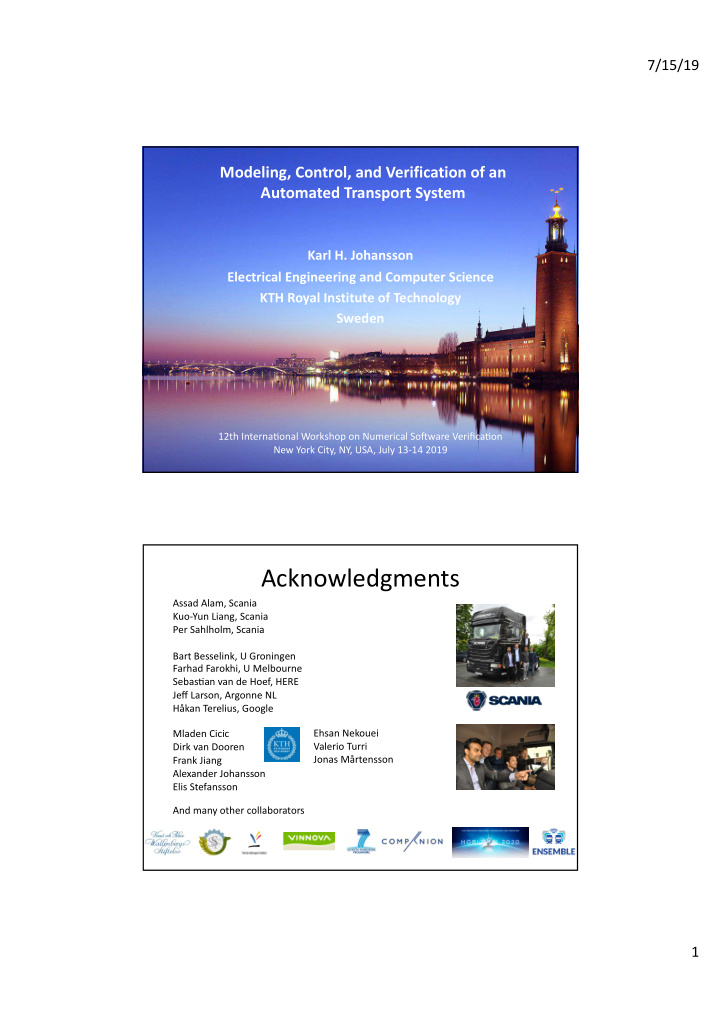



7/15/19 Modeling, Control, and Verification of an Automated Transport System Karl H. Johansson Electrical Engineering and Computer Science KTH Royal Institute of Technology Sweden 12th Interna/onal Workshop on Numerical So<ware Verifica/on New York City, NY, USA, July 13-14 2019 Acknowledgments Assad Alam, Scania Kuo-Yun Liang, Scania Per Sahlholm, Scania Bart Besselink, U Groningen Farhad Farokhi, U Melbourne Sebas/an van de Hoef, HERE Jeff Larson, Argonne NL Håkan Terelius, Google Mladen Cicic Ehsan Nekouei Dirk van Dooren Valerio Turri Frank Jiang Jonas Mårtensson Alexander Johansson Elis Stefansson And many other collaborators 1
7/15/19 The Problem How to efficiently transport goods over a highway network? CharacterisIcs 2 000 000 heavy long-haulage trucks in EU • - 400 000 in Germany Large distributed control system with no real-/me coordina/on today • A few large and many small fleet owners with heterogeneous truck fleets • - 97% operate 20 or fewer trucks in US Tight delivery deadlines and high expecta/ons on reliability • Goal: Maximize automation and fuel-saving cooperations with limited intervention in vehicle speed, route, and timing Why focus on fuel and automa/on? Life cycle cost for European heavy-duty vehicle Driver Fuel Total fuel cost 80 k€/year/vehicle Schittler, 2003; Scania, 2012 2
7/15/19 B. Besselink et al., Cyber-physical control of road freight transport. Proceedings of IEEE, 104:5, 1128-1141, 2016. 25 MEUR EU project on mul/-brand platooning 2018-2021 Control of Vehicle Platoons PATH platoon demo San Diego 1997 Swedish success stories Scania Volvo 3
7/15/19 The Physics Norrby (2014), Liang (2016) Air Drag Reduc/on in Truck Platooning 5-20% fuel reduction potential Air drag reduction [%] Truck 3 Truck 2 Truck 1 Rela/ve distance in platoon [m] P Low T 3 T 2 Lead P High Truck 3 Truck 2 Truck 1 Wolf-Heinrich & Ahmed (1998), Bonnet & Fritz (2000), Scania CV AB (2011) 4
7/15/19 Vehicle System Architecture Data from other vehicles Own position and velocity Pos from vehicle ahead CACC − Collaborative adaptive cruise control EMS − Engine management system ACC − Adaptive cruise control BMS − Brake management system CC − Cruise control GMS − Gear management system Alam et al., 2014 Platoon System Architecture CACC − Collaborative adaptive cruise control ACC − Adaptive cruise control CC − Cruise control Alam et al., 2014 5
7/15/19 How to Control Inter-vehicular Spacings? • Limited sensing and inter-vehicle communication suggests distributed control strategy • Important to attenuate disturbances: string stability • Extensively studied problem in ideal environments – E.g., Levine & Athans (1966), Peppard (1974), Ioannou & Chien (1993), Swaroop et al.(1994), Stankovic et al. (2000), Seiler et al. (2004), Naus et al. (2010) Middleton & Braslavsky, 2010 Experimental Setup Alam, 2014 6
7/15/19 Experimental Results Platoon oscillations Challenge How to handle topography variations ? Which spacing policy to choose? Alam, 2014 Spacing Policies Besselink & J, 2017 7
7/15/19 Spacing Policies Besselink & J, 2017 Spacing Policies Besselink & J, 2017 8
7/15/19 Spacing Policies Besselink & J, 2017 Constant Time Gap Spacing Policy For the constant time gap policy it holds that Control objective: Besselink & J, 2017 9
7/15/19 Disturbance String Stability Besselink & J, 2017 Besselink & J, 2017 10
7/15/19 Control Design Besselink & J, 2017 Simulations with Platoon Coordinator and Look-ahead Road Grade Information Successful tracking of common platoon velocity reference Turri et al., 2015 11
7/15/19 Cellular Implementation of Platoon Coordinator • Platoon coordinator generates common velocity reference: • Can be computed in the cellular system • New handover scheme for moving control computations between base stations van Dooren et al., 2017 Controller Code Handover Supporting Vehicle Platooning Control computa/ons move within cellular network under • Proposed new handover schemes for 5G guaranteed control performance • Support real-/me control from edge cloud 5G test network @ KTH launch Dec 5, 2018 van Dooren et al., 2017, 2018 12
7/15/19 Platoon Formation Merge and split vehicle Predictions on whether it is beneficial platoons on the fly for a vehicle to catch up another vehicle Optimal speed profiles for platoon formation Liang et al., 2016 Platoon Formation Feedback control of merging point based on real-time vehicle states and traffic information Traffic and Formation Vehicle Controller Predictor Optimal speed profiles for platoon formation Liang et al., 2016; Cicic et al., 2017 13
Recommend
More recommend